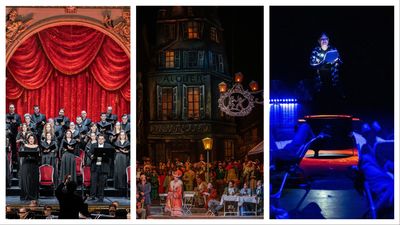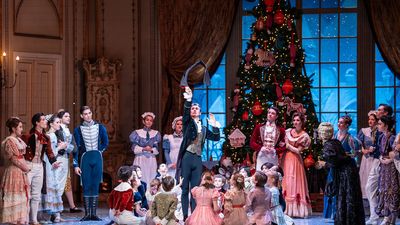
Three hundred and fifty singers, dancers and musicians from the Hungarian State Opera will take over the David H. Koch Theater for two weeks when the Hungarian State Opera and Hungarian National Ballet make their U.S. debuts, October 30-November 11, in programs featuring a series of U.S. premieres and new productions. The announcement of the engagement was made by Szilveszter Ókovács, General Director of the Hungarian State Opera today (March 14) at the Hungarian Consulate in New York City.
The first week of the engagement features the Hungarian State Opera in U.S. premiere performances of Ferenc Erkel’s Bánk Bán and János Vajda's Mario and the Magician, as well as Karl Goldmark’s rarely seen The Queen of Sheba, and Béla Bartók’s Bluebeard’s Castle. The second week features two full length ballets including the U.S. premieres of new productions of Swan Lake and Don Quixote, plus a third program of contemporary dance classics by Hans van Manen. The 100-member Hungarian State Opera Orchestra will play live for all performances during the two weeks. Additionally, the Hungarian State Opera and Hungarian National Ballet will host a gala on Sunday, November 4 at 8:00 p.m. Further ancillary events to be announced.
The Hungarian State Opera has a remarkable tour history. The company has been seen around the world for a century, with performances being staged in numerous European capitals and in countries from Egypt to Japan, making these first performances in the U.S. particularly significant.
Considered Hungary’s national opera, Ferenc Erkel’s Bánk bán (1861) is the traditional season-opener of the Hungarian State Opera. The composer, who also wrote Hungary’s national anthem, is considered the father of Hungarian grand opera and in 1884 founded the Hungarian State Opera, serving as its first music director. Bánk bán features a libretto by Béni Egressy based on Hungarian poet and playwright József Katona’s 1819 historical tragedy of the same title, one of the most important works in Hungarian literature. Centering on the character of Bánk, a medieval court official who becomes involved in a conspiracy against the king’s German-born wife, the play reflects Hungarian resistance to foreign rule and was famously staged at the outbreak of the Hungarian Revolution of 1848. Bánk bán will be performed Tuesday, October 30 at 8:00 p.m. and Saturday, November 3 at 8:00 p.m.
The Queen of Sheba is the first opera by Hungarian-born composer Karl Goldmark, who spent most of his life in Vienna. Following the success of the opera’s 1875 premiere, it was performed at the Vienna Opera nearly every year until 1938. The Queen of Sheba had its U.S. premiere at the Metropolitan Opera House on December 2, 1885 and was last performed there on January 27, 1906. It has not been fully staged in New York since. The Queen of Sheba will be performed Wednesday, October 31 at 8:00 p.m. and Friday, November 2 at 8:00 p.m.
The Hungarian State Opera gave the world premiere of Bartók’s Bluebeard’s Castle on May 24, 1918 and has since staged more than 500 performances. From May 24 to 27, 2018, the company celebrates the opera’s centennial with a new production premiere and additional outdoor performances of the opera in the plaza outside the opera house. János Vajda’s Mario and the Magician, premiered by the company in 1988, is one of Hungary’s most successful contemporary operas. The libretto is based on Thomas Mann’s 1929 anti-fascist novella Mario und der Zauberer, which criticizes Italian nationalism and tells the story of a manipulative hypnotist. A double-bill of Bluebeard’s Castle and Mario and the Magician will be performed Thursday, November 1 at 8:00 p.m. and Saturday, November 3 at 1:00 p.m.
Although American audiences won't have their first glimpse of the Hungarian National Ballet in live performance until the gala on November 4, the dancers are visible on screen in the newly released film Red Sparrow, whose ballet scenes were set on the stage of the Opera House in Budapest. Tamás Solymosi, a former principal dancer with American Ballet Theatre, is ballet director and artistic director of the 120-member company. The dancers' impeccable technique, stylistic and dramatic versatility will be front and center in all three New York City programs beginning with Rudi van Dantzig's opulent 1988 production of Swan Lake. While using the traditional story of the Marius Petipa and Lev Ivanov 1895 classic, much of van Dantzig's choreography is completely original. Both the new choreography, as well as the spectacular new sets created for the Hungarian staging and the flawless dancing and acting were greeted with great acclaim when the ballet was first performed by the Hungarian National Ballet in 2015. Swan Lake will be performed Tuesday, November 6 at 7:00 p.m., Wednesday, November 7 at 7:00 p.m., and Thursday, November 8 at 7:00 p.m.



